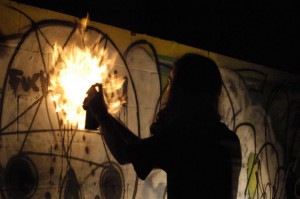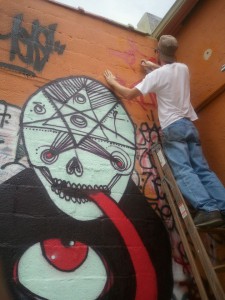
Draped in anonymity and the cover of night, the artist known as STOIC finds his peace of mind in the solitude of dark streets and the application of wet paint to concrete.
He works with his face half covered to protect his identity from unfriendly eyes. Some fail to see anything more than property damage in his masterpieces. That’s OK with him. He knows that it’s the right place for his work.
His tags appear on the backs of buildings, down narrow roads and in the periphery of anyone walking downtown. STOIC’s trademark skulls stare eerily out from their stone canvases, daunting any who might dare remove them.
Now for the first time, his art has come off of the streets and into a studio setting for an exhibit at the Venture Compound entitled “Cheaper than Arrows”. A press release for the opening announced that police need not show up, as STOIC would not be there in person.
“I painted the gallery all black and painted a huge skull god spanning from one wall across the floor and meeting up with a collage mural done by my friend Bradley [Kokay]. His wall consists of another ‘god’ in his realm of space,” said STOIC, who doesn’t associate his real name with his artwork. “I wanted to create a void, a space to feel lost in, a room in which you could really feel as if you were in another place. There are also five more 4-foot skulls spanning across the adjacent wall. Each one represents a letter in STOIC.”
His affinity for startling images is almost as old as he is. STOIC doesn’t remember his first sketches, though he’s been told he was a toddler. He stole important papers from his mother and drew “these weird little monster guys” on them before hiding them in a drawer.
He started getting up—a term for tagging—when he was about 13.
“Back then I really didn’t know much about the culture, I just loved the colors, characters and letters that went along with the graffiti movement,” he said.
Through experimentation, he developed a palette of media that suited his artistic visions. Water-based paints give him the fluidity and flexibility he likes, as each mark has “a mind of its own.” But he doesn’t limit himself to traditional painting materials, as he lists “items of impermanence” as “his thing.”
Like his love of art, the origin of his pseudonym comes deep from his past. The idea was spurred by an experience he had in 10th grade.
“My English teacher used to write a word of the day and I would always write the words in graffiti letters on my folders,” he said. “One day the word was ‘stoic’, and I liked the way it flowed. I looked into where the word stoic came from and discovered the Stoics, and ancient group of Greeks who studied the practices of stoicism. They would block out distracting emotions and discourse from the world around them in order to find peace within themselves.”
It stuck, and he’s been using it for over 10 years.
For inspiration, STOIC looks no farther than his immediate surroundings—especially to things that have fallen into disrepair.
“I find beauty is deterioration,” he said, noting that while a city building can a symbol of power and importance, it will begin to break down and fall to pieces.
“Then out of these broken down pieces, new life sprouts. It becomes a new thing entirely,” he said. “My street pieces go through this same process. They start out being these very powerful images and over time they break down into almost nothing. But their presence is still there.”
A student of art history—especially art related the cradle of civilization—he uses many ancient symbols for the afterlife and reincarnation in his work. “I believe our society is going through a death, and then a rebirth shall come from the broken pieces,” he said.
STOIC laughs off questions about possible property damage that his work has caused.
“In retrospect, hasn’t the city caused way more damage than I have? I personally don’t believe my pieces are damaging. They mostly consist of stickers, paper, and paste. You can just peel that stuff right off if you don’t like it,” he said, questioning the city’s choice to paste “off-colored” squares over his work.
He has no doubt that the street is the ideal gallery for his art.
“It’s nice to create work and get a response without people knowing who I am,” he said.
“I have been doing this for so long I know exactly what I am doing. It is rewarding to walk away from a big piece. I don’t necessarily get a rush, but it makes me feel good,” he said. “Most of the time I put my work up with people all around me, and I do it so relaxed that people don’t even noticed me. I have been caught at it when I was younger, but up to date I have not been caught as STOIC. There have been some very, very close calls, but I got away.
“I am a ghost that aimlessly wanders, leaving my marks along the way,” he said.
Aside from visual art, STOIC also creates music—a further projection of the same artistic soul in his street work. He uses outdated samples and instruments to create “down-tempo, dark and airy” hip-hop. He has released four albums under his STOIC name, including a recent EP titled “Cheaper than Arrows.” The title comes from a tale from when England was at war with France, he explained. As the French stormed London, an army general asked the king if he should send out the archers. The king replied, “No, send out the peasants first, for they are cheaper than arrows!”
“In this society we are cheaper than arrows,” STOIC said.
The closing reception for “Cheaper than Arrows” will take place on Nov. 16 at the Venture Compound. Prints and stickers of STOIC’s work will be available for $5 to $10. His friends in the band Redfeather are using the event as an album release party. The bands Permanent Makeup, Noctambulo, Memphibians and Archaic Interest will also play.
As for the future, STOIC plans to remain a force at work in the shadows. He’s working on a show featuring bug specimens entitled “Lost Friends Who Lose Their Lives to Insecticides,” as well as a fall series on leaves.
Photos courtesy of the Venture Compound.




